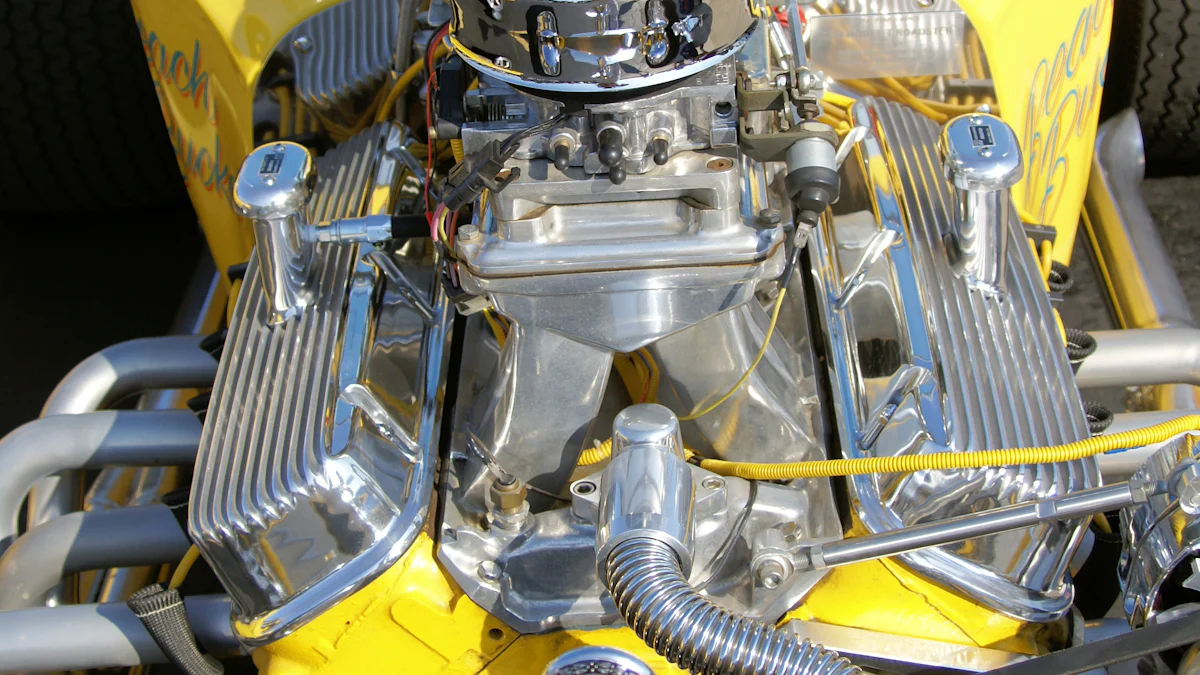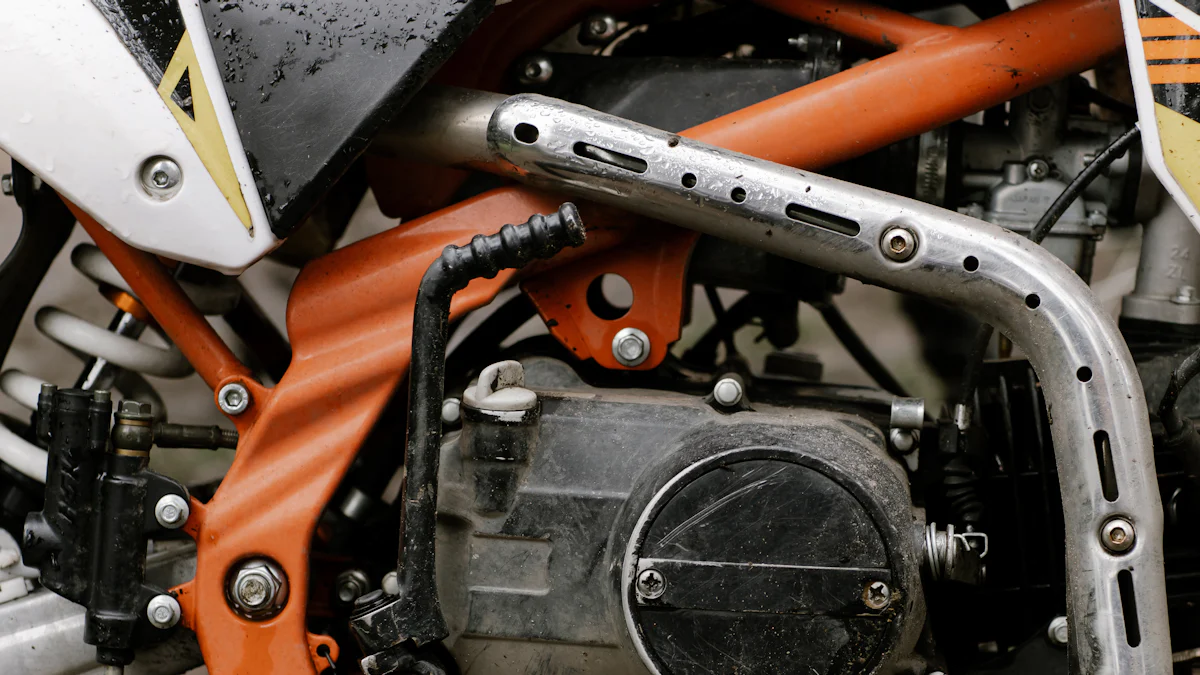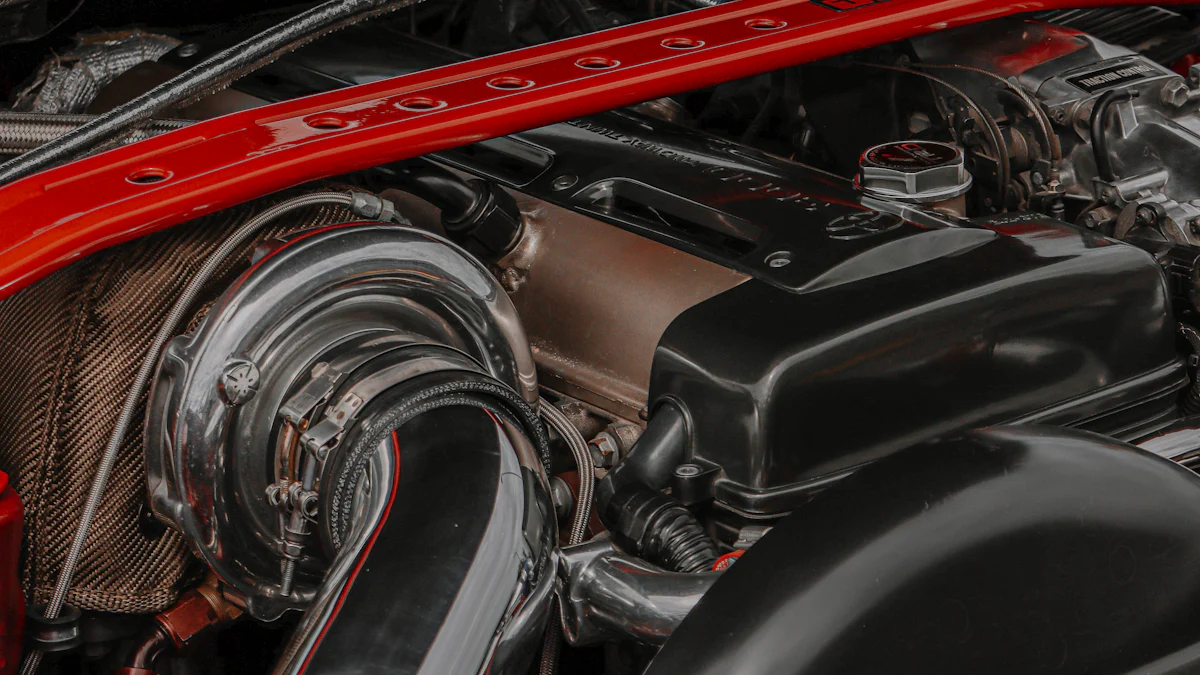
A harmonic balancer is a crucial component in your vehicle’s internal combustion engine. It plays a vital role in reducing vibrations and ensuring smooth operation. By attaching to the crankshaft, it helps balance the rotational forces, preventing damage to the engine. Understanding the specifications of a GM Harmonic Balancer is essential for maintaining engine health. This knowledge allows you to choose the right part for your vehicle, ensuring optimal performance. Crankshaft Pulleys work in tandem with the balancer, contributing to the overall efficiency and longevity of your engine.
Essential Features of Harmonic Balancers
Understanding the essential features of a harmonic balancer is crucial for maintaining your engine’s health and performance. Let’s explore these features in detail.
Material Composition
The material composition of a harmonic balancer significantly impacts its effectiveness. Most balancers consist of two main components: an inertia mass and an energy-dissipating element. The inertia mass, often made from steel or cast iron, helps counteract the torsional forces generated by the crankshaft. The energy-dissipating element, typically composed of rubber or synthetic elastomers, absorbs vibrations. This combination ensures that the damper effectively reduces torsional vibrations, enhancing engine longevity. Upgrading to a high-performance harmonic balancer can further improve your engine’s durability.
Size and Weight
Size and weight play a pivotal role in the functionality of a harmonic balancer. The balancer must match the factory spec of your vehicle to ensure optimal performance. A properly sized damper aligns with the crankshaft, effectively minimizing torsional vibrations. The weight of the balancer also influences its ability to absorb energy. A heavier damper can better counteract the torsional forces, providing a smoother engine operation. However, it’s essential to choose a balancer that suits your specific engine configuration to avoid any adverse effects on performance.
Design and Construction
The design and construction of a harmonic balancer determine its efficiency in reducing vibrations. A well-designed balancer integrates seamlessly with the crankshaft, acting as a vibration damper. It should feature a robust construction to withstand the stresses of engine operation. Some balancers, like the GM Harmonic Balancer, are engineered to meet or exceed OEM specifications, ensuring a perfect fit for your vehicle. By aligning the balancer with your engine’s configuration, you pave the way for enhanced performance and durability. A quality crankshaft damper not only minimizes vibrations but also contributes to improved torque management, leading to better fuel efficiency.
Impact of Harmonic Balancer Features on Engine Performance
The features of a harmonic balancer significantly influence your engine’s performance. By understanding these impacts, you can make informed decisions about maintaining and upgrading your vehicle.
Vibration Reduction
A harmonic balancer acts as a crucial damper in your engine. It reduces torsional vibrations that occur during the combustion process. These vibrations can cause wear and tear on the crankshaft and other components. By minimizing these forces, the damper ensures smoother operation and prolongs the life of your engine.
- Scientific Research Findings:
- Studies have shown that harmonic balancers effectively reduce engine vibrations, ensuring longevity and smooth operation. Upgrading to performance harmonic balancers can further enhance engine durability.
The damper’s ability to absorb and dissipate energy helps maintain engine balance. This balance is vital for preventing damage and ensuring that your vehicle runs efficiently. A well-functioning vibration damper not only protects the engine but also contributes to a quieter and more comfortable driving experience.
Fuel Efficiency
The design and construction of a harmonic balancer also play a role in improving fuel efficiency. By reducing torsional vibrations, the damper allows the engine to operate more smoothly. This smooth operation leads to better torque management, which directly impacts fuel consumption.
- Scientific Research Findings:
- Harmonic balancers influence engine performance and longevity by mitigating torsional vibrations, reducing noise levels, and enhancing fuel efficiency and power output.
When your engine operates efficiently, it requires less fuel to produce the same amount of power. This efficiency translates into cost savings at the pump and a reduced environmental footprint. By investing in a high-quality damper, you not only enhance your vehicle’s performance but also contribute to a more sustainable driving experience.
Types of Harmonic Balancers and Their Applications

Understanding the different types of harmonic balancers and their applications can help you make informed decisions for your vehicle’s engine. Let’s explore the options available to you.
OEM vs. Aftermarket Balancers
When choosing a harmonic balancer, you often face the decision between OEM (Original Equipment Manufacturer) and aftermarket options. Each has its own set of advantages and considerations.
- OEM Balancers: These are designed to match the original specifications of your vehicle’s engine. They ensure a perfect fit and maintain the integrity of the crankshaft. OEM balancers are reliable and often preferred for maintaining the original performance of your vehicle. They are ideal if you want to preserve the factory settings and ensure compatibility with your engine’s existing components.
- Aftermarket Balancers: These offer a wider range of options, including performance enhancements. Aftermarket balancers can provide improved vibration damping and durability. They are often favored by enthusiasts looking to upgrade their vehicle’s performance. However, it’s crucial to select a reputable brand to ensure quality and compatibility with your engine.
Expert opinions and customer reviews suggest that when selecting a harmonic balancer for Big Block Chevy engines, both OEM and aftermarket options have their merits. Your choice should depend on your specific needs and preferences.
Performance Balancers
Performance balancers are designed for those seeking to enhance their vehicle’s capabilities. These balancers focus on optimizing the damper’s ability to reduce torsional vibrations and improve overall engine performance.
- Enhanced Vibration Damping: Performance balancers are engineered to provide superior vibration reduction. They often feature advanced materials and construction techniques to achieve this. By minimizing torsional forces, these balancers help protect the crankshaft and other engine components from wear and tear.
- Improved Torque Management: With better vibration control, performance balancers contribute to smoother torque delivery. This results in a more responsive engine and can lead to improved fuel efficiency. Whether you’re racing or simply want a more dynamic driving experience, performance balancers can make a noticeable difference.
- Application Versatility: Performance balancers are suitable for a variety of applications, from street cars to high-performance racing vehicles. They offer flexibility in terms of design and compatibility, allowing you to tailor your choice to your specific engine setup.
By understanding the types of harmonic balancers and their applications, you can make an informed decision that aligns with your vehicle’s needs and your performance goals.
Choosing the Right Harmonic Balancer for Your Vehicle
Selecting the right harmonic balancer for your vehicle involves understanding several key factors. This decision impacts your engine’s performance and longevity. Let’s explore the considerations you should keep in mind.
Considerations Based on Vehicle Type
Your vehicle type plays a crucial role in determining the appropriate harmonic balancer. Different vehicles have unique engine configurations and requirements. Here’s what you need to consider:
- Engine Specifications: Ensure the balancer matches your engine’s specifications. This includes the crankshaft size and the damper’s compatibility with your engine’s torque spec. A mismatch can lead to inefficient vibration damping and potential engine damage.
- Crankshaft Compatibility: The balancer must fit seamlessly with your crankshaft. This ensures effective torsional vibration reduction. A well-matched balancer maintains engine balance and prevents wear on the crankshaft and other components.
- OEM vs. Aftermarket Options: Decide between OEM and aftermarket balancers. OEM balancers offer a perfect fit for factory settings, while aftermarket options provide performance enhancements. Choose based on your vehicle’s needs and your performance goals.
Expert Testimony:
Brian LeBarron, an expert in Fluidampr Harmonic Balancers, emphasizes the importance of customer-driven development. He states, “We encourage engine builders and the industry as a whole to help drive the process so we can exceed user needs.” This highlights the significance of selecting a balancer that aligns with your vehicle’s specific requirements.
Usage and Driving Conditions
Your driving habits and conditions also influence the choice of a harmonic balancer. Consider the following factors:
- Driving Environment: If you frequently drive in harsh conditions, such as off-road or extreme temperatures, opt for a balancer designed for durability. These balancers withstand the stresses of challenging environments, ensuring reliable performance.
- Performance Needs: For high-performance vehicles, choose a balancer that enhances torque management and reduces torsional vibrations. Performance balancers improve engine responsiveness and fuel efficiency, making them ideal for racing or spirited driving.
- Maintenance and Longevity: Consider the maintenance requirements of the balancer. Some balancers require regular checks and adjustments to maintain optimal performance. Choose a balancer that aligns with your maintenance capabilities and long-term reliability expectations.
Expert Insight:
Industry professionals evaluate harmonic balancers based on durability and compatibility with different engine configurations. Their assessments help enthusiasts make informed decisions, ensuring the balancer meets performance metrics and long-term reliability.
By considering these factors, you can select a harmonic balancer that suits your vehicle type and driving conditions. This choice ensures your engine operates smoothly, providing a reliable and efficient driving experience.
Installation and Maintenance Tips

Proper installation and maintenance of your harmonic balancer are crucial for ensuring optimal engine performance and longevity. By following these guidelines, you can effectively manage the damper’s role in reducing torsional vibrations and maintaining engine balance.
Proper Installation Techniques
- Preparation: Before installing the harmonic balancer, ensure that all components, including the crankshaft and flexplate or flywheel bolts, are clean and free from debris. This step prevents any interference during installation.
- Alignment: Carefully align the balancer with the crankshaft. Proper alignment is essential for effective vibration damping. Misalignment can lead to increased torsional forces, which may damage the engine over time.
- Torque Specifications: Use a torque wrench to tighten the balancer to the manufacturer’s specified torque spec. This ensures that the damper is securely attached, preventing any loosening during engine operation. Proper torque application is vital for maintaining engine balance and preventing premature wear.
- Inspection: After installation, inspect the damper for any signs of misalignment or damage. A visual check helps identify potential issues early, allowing for timely corrections.
Tom and Pat, experts in automotive maintenance, emphasize the importance of proper installation techniques. They state, “Ensuring the harmonic balancer is correctly installed can prevent many common engine issues.”
Maintenance Best Practices
- Regular Inspections: Conduct regular inspections of the harmonic balancer to detect any signs of wear or damage. Look for cracks, excessive wear, or any unusual noises during engine operation. Early detection of issues can prevent costly repairs.
- Replacement Schedule: Follow the manufacturer’s recommended replacement schedule for the damper. Over time, the materials in the balancer can degrade, reducing its effectiveness in damping torsional vibrations.
- Professional Assistance: If you notice any irregularities or are unsure about the condition of your harmonic balancer, seek professional assistance. Automotive experts can provide a thorough assessment and recommend appropriate actions.
- Environmental Considerations: Consider the driving conditions your vehicle frequently encounters. Harsh environments may require more frequent maintenance checks to ensure the damper remains in optimal condition.
Experts from various automotive fields highlight the critical role of regular maintenance. They note, “Regular maintenance and early detection of harmonic balancer issues are essential for maintaining engine performance, especially in high-performance vehicles like the Corvette.”
By adhering to these installation and maintenance tips, you can ensure that your harmonic balancer continues to perform effectively, contributing to a smoother and more efficient driving experience.
In this blog, you explored the vital features of a harmonic balancer and its impact on your engine’s performance. Understanding the specifications of the damper is crucial for maintaining engine health and efficiency. You learned about the importance of material composition, size, weight, and design in selecting the right damper for your vehicle. By considering these factors, you ensure that the crankshaft operates smoothly, reducing vibrations and enhancing longevity. Prioritize these insights when choosing a harmonic balancer to optimize your vehicle’s performance and reliability.
Post time: Nov-18-2024



